Maximize the Potential of Your Comics
CGC is the world's leading comic book pressing, restoration and restoration removal company.
Enhanced Appearance and Desirability
Through its proven processes, CGC has enhanced the appearance and desirability of comic books for countless collectors and dealers. Pressing is offered in conjunction with CGC's grading services, creating a streamlined process that saves submitters both time and money.
Submit to CGC today!
Learn moreWhat Pressing Can Do
Mishandling and exposure to the elements can cause any comic book to suffer from bends, creases, tears, missing pieces, stains and tanning. Unwanted repairs - such as color touch, glue and tape - can also reduce the appeal of a comic book. CGC specializes in the correction or removal of these defects and repairs to improve a comic's appearance or desirability.
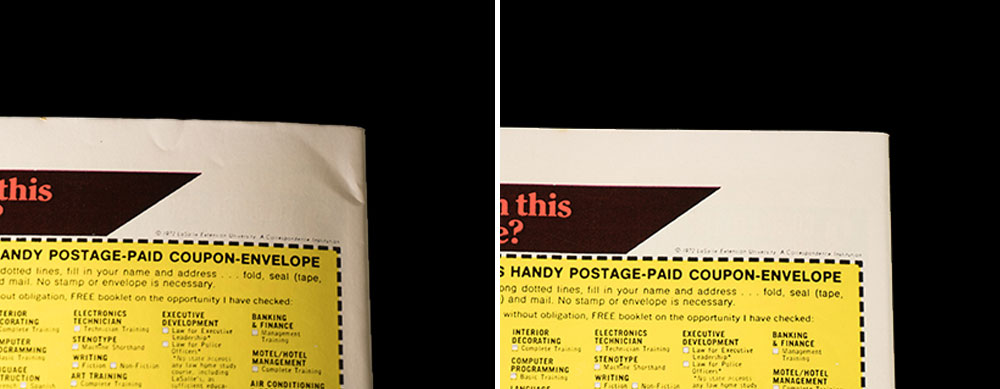
Bends
Curved or bent areas of paper that do not break color, on or through the book.

Corner Crunch
Corner of the book that has been impacted to cause multiple bends in both directions through the book.
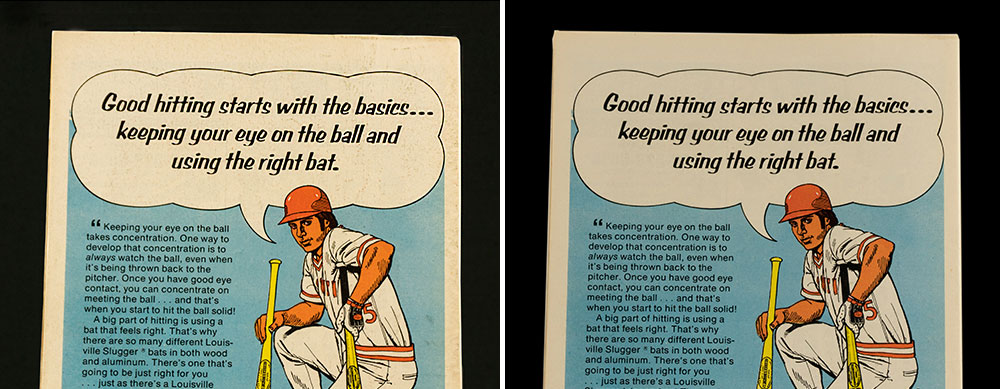
Dirt
Foreign substance on book due to handling or from contact with another object.
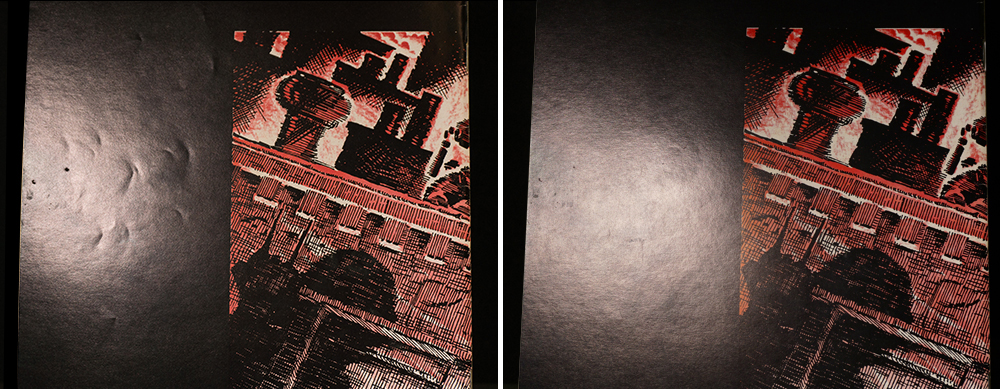
Finger Bends
Bends created by the frequent handling and reading of the book, impacted by one's fingers.
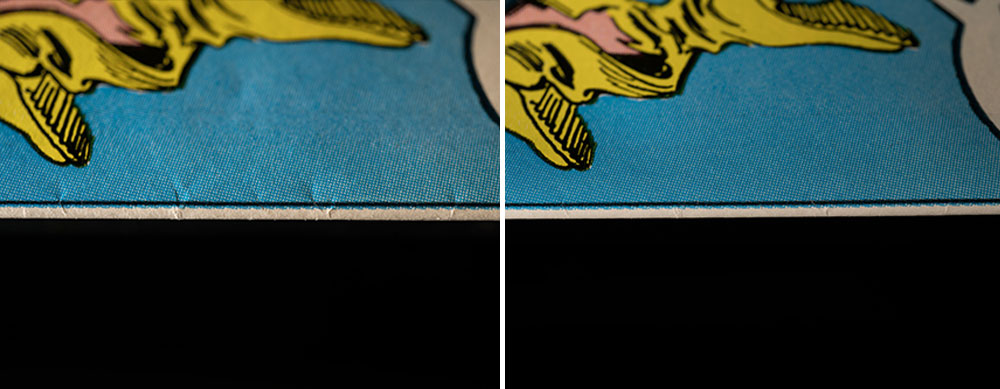
Non-color-breaking spine stress
Bends along the spine of a comic book that do not break color, usually resulting from a curling of the spine.
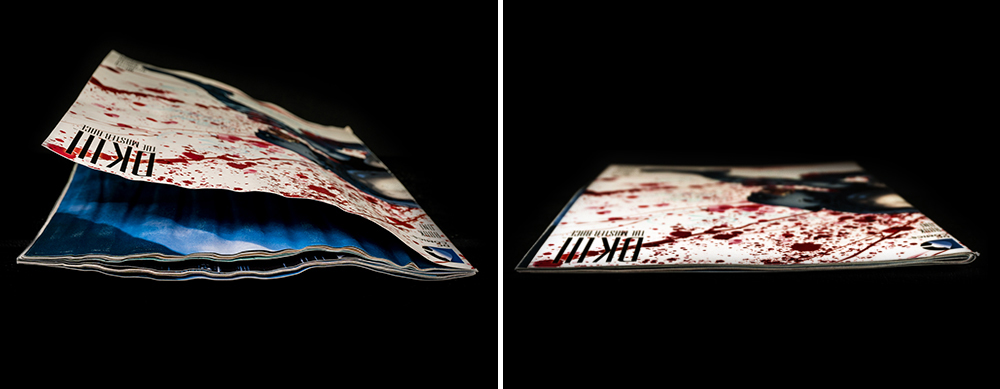
Ripples
Tight areas of waves, often caused by exposure to moisture.
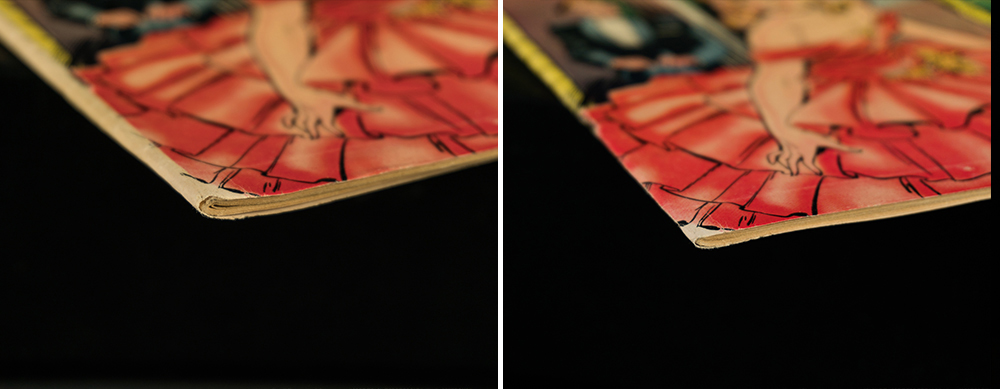
Spine Roll
A condition where the left edge of the comic curves toward the front or back, caused by folding back each page as the comic was read.
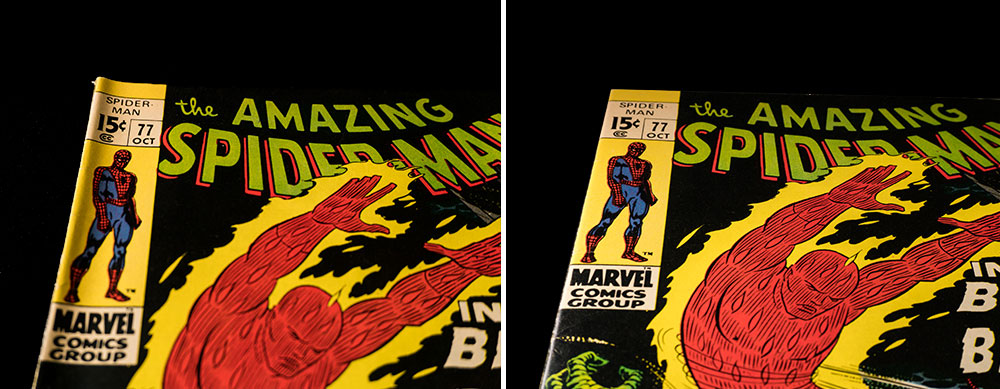
Stacking bends
Large bends caused by the weight and pressure of other books or objects resting on top of the book for a prolonged period.
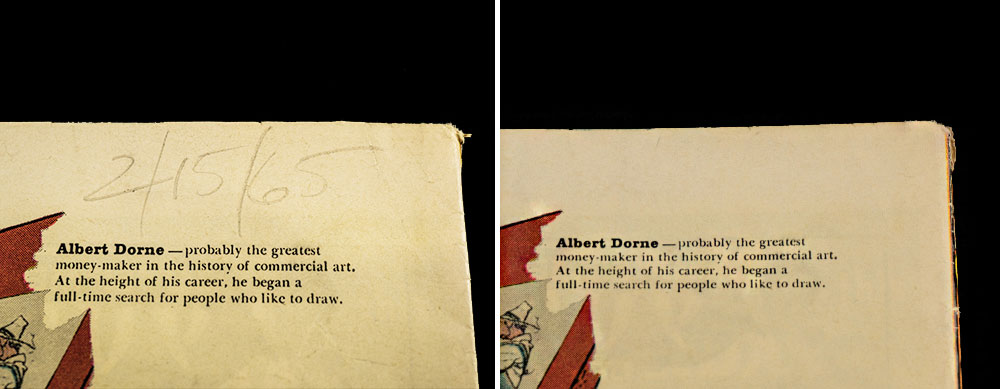
Writing
Any marks created by a pencil to the book.
Pressing Services
View our turnaround times and fees >
Screening
CGC offers a Screening service to determine whether your comic book is a suitable candidate for Pressing (excludes Modern Tier), Restoration or Restoration Removal. The Screening fee is 1% of the fair market value (£15 minimum) of the comic at the time of Screening.
The 1% screening fee will be waived if a service is performed. If no service is deemed suitable for the comic, the maximum fee charged will be £50. If service is deemed suitable but you decide not to have the work done, the full screening fee will be charged.
Raw books, CGC-certified books and non-CGC-certified books may be evaluated for Pressing (excludes Modern Tier). If CGC believes that Pressing would not benefit the comic, you will pay only the Screening fee. If CGC-certified books submitted for Screening are rejected, CGC will return the book in the CGC holder. Non-CGC-certified books will be assessed through the holder, and if they are rejected they will be returned in the same holder.
If multiple comics are submitted for Screening but only a portion are deemed suitable Pressing candidates, those not receiving service will be held until Pressing is complete. This allows the entire order to be transferred for grading together.
At no time will a comic be assessed for a grade during Pressing, nor will CGC graders be made aware that a comic has been pressed (except in instances where Restoration or Restoration Removal has also been performed). The Pressing of a comic may have no impact on the grade subsequently assessed by any comic book certification company or individual.
Restoration Check
A restoration check is included with each screening. If restoration is detected, it will be assessed for removal. If removal cannot be performed, the book will be rejected for service. If restoration is present and is missed during screening, and the restoration is removable, CGC will remove it for free and the book will be re-graded by CGC at no additional charge. If the restoration is not removable, all CGC fees will be refunded and the book returned raw.
Restoration Removal (Screening required)
Screening is required for books submitted for the Restoration Removal service, CGC will determine the feasibility of restoration removal and evaluate whether a comic is an appropriate candidate for restoration removal. If CGC believes that restoration removal will not benefit the comic, you will pay only the screening fee.
Certified comics will be evaluated in the holder, and if rejected for removal, will be returned in the same holder. In rare instances a certified book slated for removal may be rejected after the book is removed from the holder. If the book is CGC-certified, it will be reholdered at no cost. If the book is not CGC-certified, it will be returned raw.
Restoration (Screening required)
Screening is required for books submitted for Restoration. The screening service will determine the feasibility of restoration, the extent of restoration that would be appropriate, the fee and the approximate turnaround time. If CGC believes that it should not perform restoration, you will pay only the screening fee. CGC-certified books that are rejected for restoration will be returned in the CGC holder.
Downgrades, Missed Restoration and Damage
No matter the service that may be applied, CGC does not guarantee that a comic will receive a certain grade from CGC. While rare, it is possible that a comic can receive a lower grade from CGC after Pressing. Additionally, it is possible that Pressing will not lead to any grade change no matter how successful the service might have been. Furthermore, because of the nature of Restoration and Restoration Removal, CGC cannot guarantee a particular outcome. For more information, please review the CGC Services CCG UK Services Terms and Conditions.
Because of the interactive nature of pressing, there is always a possibility of damage occurring to the comic book. This generally only happens if a comic book is in fragile condition, including books that are tanned or brittle, spines exhibiting splits, loose paper on the staples, or pieces that are barely attached. To mitigate the possibility of damage, it is recommended that each book is examined for these defects prior to submission. When in doubt, the CGC screening service should be utilized to assess safety.
Because it is impossible to ensure that damage will not occur, CGC will not be held liable for split spines, covers or pages detached from staples, or detached pieces.
Pressing
Pressing is a process that can enhance the appearance of a comic book by removing non-color breaking defects such as dents, bends, crunches, rippling, warping, spine rolls and indentations. It neither adds nor takes away from the comic, making it a non-restorative process that will not make a comic book “restored.” Dry cleaning a comic to remove soiling and any unwanted substance is also considered a non-restorative process, and is included in the CGC pressing service when necessary.
CGC is the industry leader in comic book pressing. Our multi-step process has been modified and honed through thousands of hours of research and development. We’ve pressed hundreds of thousands of comics, many of them regarded as the most valuable in the hobby. Our experienced Pressing team has been entrusted with pedigrees, key issues, modern comics, signature series, atypical comics, and abnormal defects, all with expert results.
We have broken down the most basic questions below. When you feel that you are ready to submit your books to CGC for pressing, go to our submission page to start the process.
Restoration Removal
Oftentimes a comic book exhibits minor, unnecessary restoration, and its presence has a detrimental effect on the comic’s value. But if the restoration is reversible, or is small enough to remove, the Restoration Removal service is very beneficial. The goal of removal is for the book to receive an unrestored grade from CGC.
What restoration is deemed removable depends on a few factors; whether the restoration is slight in nature, if it was professionally applied, if the materials used can be removed without damaging the comic, and what effect the removal will have on the grade of the comic.
Restoration/Conservation
A very important step is determining which comic books should be restored or conserved. In today’s market, candidates must be chosen based on the current condition and value of a comic, what apparent grade that comic can achieve through restoration or conservation, and the cost involved. In truth, most comic books do not benefit from restoration or conservation, either because the cost outweighs the benefit, or because the comic is worth more in its current state than it would be if either service was performed.
In 2014, CGC introduced its conservation category, which is a more specific classification of restoration. It includes only work that is professional and slight in nature with the purpose of sustaining a comic’s structural integrity.
One of our more revolutionary comic book restoration processes is called leaf casting, which has dramatically improved the appearance of comics we restore. Leaf casting is used by most historical conservationist labs across the world, and incorporating this process into comic book restoration now brings us in line with other fields of historical ephemera. Kenny Sanderson is an independent consultant who has refined our leaf casting process, which now produces results that are unparalleled in our hobby.
In addition to restoration, CGC offers a conservation service as well. For a more detailed description of how CGC identifies restored and conserved comics, please visit CGC’s restoration page here.
If you think your comic book would benefit from restoration or conservation, the first step is to email us a scan of the front and back of the comic in question to Submissions@CGCcomics.uk. Based on your scan, we will determine whether either service is viable and provide a ballpark cost. If we decide the comic may benefit from restoration or conservation, the next step is to submit the comic for screening to finalize feasibility and cost. The questions and answers below will help guide you.
FAQs
Pressing
What exactly is pressing and how did it begin?
In a general sense, pressing has been around since the beginning of comic book collecting. Crude and simple methods of pressing were employed in the beginning, with little thought given to long term effects. By the ‘80s pressing became more sophisticated, serving as part of the evolving restoration process. In the ‘90s, pressing became associated with water and solvent cleaning (hence the phrase “cleaning and pressing”) and was utilized separately from traditional restoration. Some did not consider cleaning and pressing to be restoration during this time.
When CGC entered the market in 2000, they classified water and solvent cleaning as restoration, leaving only pressing as an allowable process for unrestored comic books. Over subsequent years, Matt Nelson of Classics Incorporated developed a process that maximized the outcome and minimized the hazards of pressing. In 2013 CGC acquired Classics Incorporated.
Does CGC consider pressing to be restoration?
CGC does not consider pressing to be restoration. CGC also does not consider dry cleaning to be restoration, which we automatically include in our pressing service, when necessary. Dry cleaning’s main purpose is to remove soiling or unwanted substance or writing from a cover, particularly in the white areas. Dry cleaning does not remove tanning, stains, pen or marker, sun shadows or foxing. If we feel your book’s grade would benefit from a dry cleaning, we will automatically perform this during the press process.
How do you press a comic?
We get asked this quite often, but our process is a trade secret. It’s a process we have spent thousands of hours developing through research, testing, and pressing hundreds of thousands of comics. We strive to make sure every technique is safe for the short and long term. Our pressing process does not involve disassembly or heat, nor do we use abrasive materials like chemicals, nor do we perform any work that is considered restoration.
How do I spot good pressing candidates?
The first step is to identify a comic book’s “good” defects and “bad” defects. In short, good defects can be diminished or removed with pressing, and the bad defects cannot. Here is a comprehensive list of both:
| Good defects (do not break color) | Bad defects |
|---|---|
|
Dents Bends Folds Light creases Minor spine stresses Impacted corners or edges Warping Ripples (with no stains present) Spine rolls Waviness Stacking bends Cover impressions Light pencil marks (usually in white areas) Dirt Substance |
Creases that break color Missing chips or pieces Tears Stains Detached staples or staple tears Spine stresses that break color Fading Fingerprints or smudges Dust shadows or sun shadows Rusted staples or rust stains Rounded or blunted corners Pen markings or printer ink Cover veins Brown or brittle cover or pages |
Identifying good press candidates can be challenging because it requires you to understand the projected outcome. It is important to have a comprehensive understanding of CGC’s grading standards and to be able to visualize the grade of the comic without the presence of removable defects.
It is important to note that just because a comic exhibits good defects does not mean it will automatically increase in grade with a pressing. The good defects must be weighed against the presence of any bad defects. For instance, a comic book graded 8.5 with a moderate non-color breaking bend and fingerprints may still grade an 8.5 after pressing due to the fingerprints.
What grade range is the best for pressing candidates?
There are press candidates throughout all grades, but several factors must be considered to determine if pressing is feasible.
High-grade comics (8.0 to 9.6) can greatly benefit from pressing as they tend to exhibit only minor flaws that are easily fixable. These minor increases in grade can considerably increase the book’s value and desirability.
Mid-grade comics (4.0 to 8.0) are among the best press candidates because they exhibit many more fixable flaws than high-grades, but are often free of severe defects that limit their improvability. Even though the value increase is not as substantial as high-grade comics, the potential to improve a book by many grades is greater in this range.
Low grade comics (4.0 and down) can also be good press candidates, but caution should be taken because of the potential presence of dangerous defects, such as tanning, brittleness, spine splits, covers or pages loose from a staple, and pieces that are barely attached. For high value comic books such as Amazing Fantasy #15, even small grade increases in this range are worthwhile.
Can I press restored comic books?
Yes, as long as the restoration is safely applied to the comic book. Any restoration that is tacky, sticky or loose will not be safe to press. When in doubt, utilize the CGC Screening service to determine if a restored book is safe to press.
Can you press Signature Series comics and they still retain their yellow label?
Yes. We are authorized by CGC to press Signature Series books as long as the submitter chooses to have them transferred directly from to CGC for grading. The books can either be pressed after they are signed (and before they are graded), or encapsulated Signature Series comics can be submitted in their holder for pressing. It is recommended that all signatures are obtained on a comic before pressing. It’s important to remember that if a Signature Series holder is not opened by CGC nor in the presence of a SS witness, CGC’s signature authentication is null and void.
Can I send you scans of my press candidates?
Unfortunately, scans are not a reliable method of determining press potential. If you are unsure of whether your book should be pressed, please choose the CGC screening service when you submit your comic.
What happens to the old labels for CGC books that are pressed?
When we remove a book from its CGC holder to press and transfer it to CGC, the old label is included with the book. CGC’s Receiving department will remove the grade from the Census and destroy the label. If a CGC graded book is pressed by CGC and returned to you uncertified. In this situation, it will be up to you to return the label to CGC for census accuracy.
Will CGC graders be made aware that my book has been pressed?
No. CGC graders will not be made aware of pressing, except in instances where other methods of restoration or restoration removal have also been performed. CGC’s pressing and grading services are handled completely independently from one other.
Do multiple pressings hurt my comic?
The CGC process is designed to be safely applied multiple times to remove all defects possible. If done correctly, multiple pressings do not hurt a comic, whereas one improper pressing can cause substantially more damage. Our process is often used to correct improper pressings in addition to defect removal.
What if CGC screened my comic and it still didn’t upgrade?
This is always a possibility. Despite our best efforts to accurately screen each comic for press potential, there is never a guarantee as to what CGC will grade it. We do not refund fees for books that do not upgrade after screening and pressing.
Is it possible my comic will receive a lower grade after pressing?
While rare, it is possible that a comic can receive a lower grade from CGC after pressing a certified comic. In rare instances, it may also be due to damage that has occurred to the comic book. If damage ever occurs during pressing, the customer will be notified of the damage prior to the book transferring to CGC for grading.
Because of the interactive nature of pressing, damage is always a possibility. This usually happens due to comic books in fragile condition, which includes books that are tanned or brittle, spines exhibiting splits, loose paper on the staples, or pieces that are barely attached. To mitigate the possibility of damage, it is recommended that each book is examined for these defects prior to submission. When in doubt, the CGC screening service should be utilized to assess safety.
Because it is impossible to ensure that damage will not occur, CGC will not be held liable for split spines, covers or pages detached from staples, or detached pieces.
Will you tape pieces or a cover back on to my comic?
This is something we will not do, nor do we condone anyone else doing it. While tape can technically repair a comic within the parameters of an unrestored grade, it is unsafe for the comic and will stain and break down paper over time. CGC’s policy does not allow grade increases from tape repairs, so there is nothing to gain from using it as a repair.
How do I submit my comics for pressing?
Once you’ve read through the information above and you’re ready to submit, simply go to the submission page and follow the instructions. You must be a CGC Collector member or CGC Authorized Member Dealer to submit comics for pressing. CGC is an independent members of the Certified Collectibles Group.
Are there comics that cannot be pressed?
Pressing is not effective or safe on certain comic books due to the way they are manufactured. This includes metal, chromium and acetate covers, and covers that exhibit embossing. If submitted for pressing, these books will be rejected and sent directly to grading.
Restoration Removal
How do I know if restoration can be removed from my comic book?
Knowledge of the CGC restoration scale is important in determining candidates. The scale consists of a quantity scale (1 through 5) and a quality scale (A,B,C). A comic with minimal professional restoration will receive an A-1 grade, while a heavily restored comic with poor techniques and materials will receive a C-5 grade. With few exceptions, removal candidates must be slight in nature (a quantity rating of 1). The best candidates have a high-quality rating of A or B.
CGC’s Conservation category can also yield removal candidates. Because all books given a conserved grade by CGC must meet the criteria of slight work (1) and high-quality techniques and materials (A) these books fall into the ideal parameters of removal candidacy. For a full explanation of CGC’s Conserved and Restored categories, go here.
What kind of restoration can be removed?
In general terms, the following restoration is removable if it is slight in nature: color touch, glue, piece fill, reinforcement, spine split seals, tear seals, and support. Among these, professionally applied reinforcement, spine split seals, tear seals and support using rice paper is the easiest to remove. The following restoration is not removable: cover cleaning, interior cleaning/lightening, re-glossing, trimming, staple cleaning or replacement, and moderate or extensive restoration involving piece fill and color touch.
Will my comic book go down in grade with removal?
It is important to note that the grade of a comic often decreases after restoration removal because concealed defects, such as color breaks, tears, split spines and detached covers or pages become visible again. The higher the apparent grade, the more likely the comic will experience a grade drop from removal. What ultimately determines the grade drop is the severity of the defect the restoration has repaired. For example, removal of minor rice paper support that was used to re-attach a loose cover will result in the cover becoming detached again, causing a very large drop in grade. Conversely, a small tear seal removal will have negligible effect on grade.
Will removal damage my comic book?
Removing amateur restoration such as household glue, or color touch using markers or pens that have bled through the paper can deface a comic, as it’s necessary to remove the affected parts to achieve an unrestored grade. In these cases, the potential damage that will occur from removal is carefully considered to minimize excessive harm to the comic.
Can some restoration remain for an unrestored grade?
For Golden Age comics printed prior to 1950, CGC allows very minor color touch and minor glue in their unrestored category. These CGC labels are nicknamed “blue with notes” with the term “blue” referring to the color of CGC’s unrestored universal grade, and “notes” referring to mention of the presence of very minor color touch and/or glue. When removing color touch and glue, oftentimes CGC will leave trace amounts of either to achieve the blue with notes category; this is done when complete removal of the glue or color touch may result in a lower grade.
Can my restored comic book receive a conserved grade instead?
In some cases where the present restoration cannot be removed for an unrestored grade, it is still possible to remove some restoration to achieve a conserved grade. An example would be a comic graded B-1 with a cleaned cover, tear seals and very minor color touch to a corner. Even though the cleaned cover cannot be reversed, the color touch can be removed, leaving work that meets the criteria of a conserved grade.
Can tape be removed from my comic with this service?
Even though tape is not considered restoration, many collectors prefer their comics do not exhibit tape. The CGC removal service can include tape, but only under limited conditions. Large amounts of tape require disassembly and solvent cleaning, which can constitute restoration. As a result, CGC recommends performing tape removal only when there is a very small amount of tape. Additionally, because Silver Age covers respond poorly to tape removal, CGC only recommends tape removal on non-ink areas of a Silver Age cover.
Do you need to screen my comic book for removal?
All books submitted to CGC for restoration removal require a screening to determine feasibility. During the screening process, the restoration is examined for removability, and any potential grade drop is assessed against appearance and value change. Estimated grades of the potential outcome are not given. Certified comics will be evaluated in the holder, and if rejected for removal will be returned in the same holder. In rare instances a certified book slated for removal may be rejected after the book is removed from the holder. If the book is CGC-certified, it will be re-holdered at no cost. If the book is not CGC-certified in this case, it will be returned raw.
CGC takes a conservative approach to restoration removal. We do not suggest removal for the sake of an unrestored grade when it may result in “butchering” the comic book. Although we work to achieve the best possible results, because of the unpredictable nature of removal, a particular outcome, including the comics’ grade, cannot be guaranteed.
Restoration/Conservation
When should I restore my comic book?
The market for unrestored comic books is at an all-time high, so choosing to restore a comic book is a personal decision that collectors should only make after carefully considering a number of critical variables. The more common a comic book is, the less money a restored copy of that book will fetch. The first rule of thumb is that most comic books printed after the early ‘40s are not good restoration candidates based on how common issues from the Silver and Bronze age are. For instance, a restored copy of Action Comic #1 (1938) will be much more sought after than a restored copy of X-men #94 (1975) because of how rare that issue of Action is in comparison.
Another factor to consider is the current grade. Because unrestored comics are so highly sought-after, it is often better to leave an unrestored comic as is, even if low-grade. In the past, comics in 4.0 (or even as high as 8.0) were considered for restoration, but these days, those graded 2.0 or even 1.0 are fetching more money than restored copies of the same comic. As a result, the best candidates tend to be copies in poor condition, copies that already exhibit restoration (with the intention of improving the work), and copies that contain married parts that would keep it from obtaining an unrestored grade as is.
One more factor is weighing the potential value increase against the cost of restoration or conservation. Full restoration jobs typically run £1,500, and as much as £3,500 per comic, so it is crucial to make sure the potential grade increase from restoration justifies this cost. A Superman #1 in 1.0 with slightly brittle pages and a married back cover may rise in value as much as £12,000 if a high enough grade can be achieved from full restoration. On the other hand, most restored copies of Marvel’s Daredevil #1 only fetch £750 (or less), which does not justify the cost of full restoration.
Most defects can be repaired through restoration, but some cannot, or are too difficult to repair. Extremely brittle pages make handling impossible; missing pages or covers cannot be restored without the submitter providing the same parts from a donor copy. Additionally, extensive tape removal can sometimes cause further damage by pulling up ink, especially on Silver Age comics. Other defects may hinder the potential for a comic to achieve a high grade through restoration, such as certain kinds of stains, heavy creasing, cover fading, excessive glue repairs, and heavy spine wear.
In summary, the best candidates are low grade Golden Age key issues with substantial value (Batman #1, etc.) that already exhibit restoration or married parts, and are void of extreme brittleness, heavy creasing, fading, spine wear, and large glue repairs.
When should I conserve my comic book?
The decision to conserve a comic book is a personal choice for each collector.
By comparison to restoration, conservation work is much lighter in nature, addressing only those defects that threaten the structural integrity of a comic book. This includes tear seals, spine split seals, support, piece re-attachment, tape and stain removal, and cover or staple cleaning. It excludes color touch and most piece fill, which are traditionally aesthetic repairs to enhance the appearance of a comic. Some piece fill is allowed when it supports the structural integrity, such as along the spine of a cover to insure re-attachment to its interior.
As with restoration, care should be taken when considering conservation candidates. The same rules apply as for restoration; unrestored comics in decent grade, especially more common issues, should not be conserved. But because the cost of conservation is considerably lower than restoration, a value increase vs. cost analysis can produce more viable candidates.
The main consideration for candidacy is grade increase. Since conservation does not involve aggressive repair, the best candidates tend to be attractive copies that exhibit one or two major flaws that can be corrected with only conservation repairs. One example is a cover that exhibits a cleanly split spine, but is otherwise in very nice shape. A simple spine split seal to re-attach the front and back cover to the interior can dramatically increase the grade from 1.8 to as high as a conserved 8.0.
Many low-grade copies would not benefit from conservation. One example is a comic book that has extensive bug chews to the edges. This defect can only be repaired with piece fill and color touch, two repairs that would fall in the restoration category. Another example is a detached cover that also exhibits heavy creasing, wear and missing paper. While attaching the cover through conservation may be desired, the additional defects will keep the comic from improving in grade.
Conservation work usually runs £75-£400 per comic, based on the work performed.
What are the three steps in restoration?
Step #1: Cleaning
This first step involves removing unnecessary material from a comic (dirt, stains, tape), and cleaning the cover and pages if necessary. There are three types of cleaning: dry, solvent and water. Dry cleaning removes dirt and soiling, while solvent cleaning helps remove tape, some stains and yellowing. Water cleaning rids covers of tanning, wrinkling and most stains. This step is crucial in returning the comic to an apparent state of how it appeared when it was printed, prepping it for any necessary piece fill and color touch.

Step #2: Leaf casting
Leaf casting fills in all missing paper to a cover or interior page by suspending each wrap in a liquid medium and forcing a pulp mixture through via suction. After drying, the fill is nearly seamless, and the thickness and flexibility of the original paper is closely matched. Once this step is finished, the book should be structurally complete and ready for the missing color to be replaced.

Step #3: Color Touch
Color touch is the last step in a full restoration job. Acrylic paint is used to fill and blend leaf casted areas, and missing art is recreated by hand. This is the most time consuming of the three steps. The result is a comic book that looks and feels as close to its original unrestored state as possible.

Because it excludes color touch, the CGC Conservation service only involves Step #1, and for structurally dependent fill, Step #2. Often leaf casting is substituted with rice paper repair, which is used for tear seals, spine split seals, support, and piece re-attachment.
How is the fee determined?
Fees are based on a rate of £125/hour. Exact restoration fees will be provided once CGC performs a screening of the comic, which costs 1% of the value of the comic submitted. This screening fee is waived if service is performed on the comic. Full restoration jobs typically run £1,500 to as much as £3,500 per comic. Conservation jobs average £75-£400 per comic.
How long does it take to restore my comic book?
Our turnaround time varies, depending on what work needs to be performed. Conservation services typically take 3-4 months. Full restoration can range from 6 months to over a year, depending on the volume of CGC submissions and how much restoration your comic book needs.